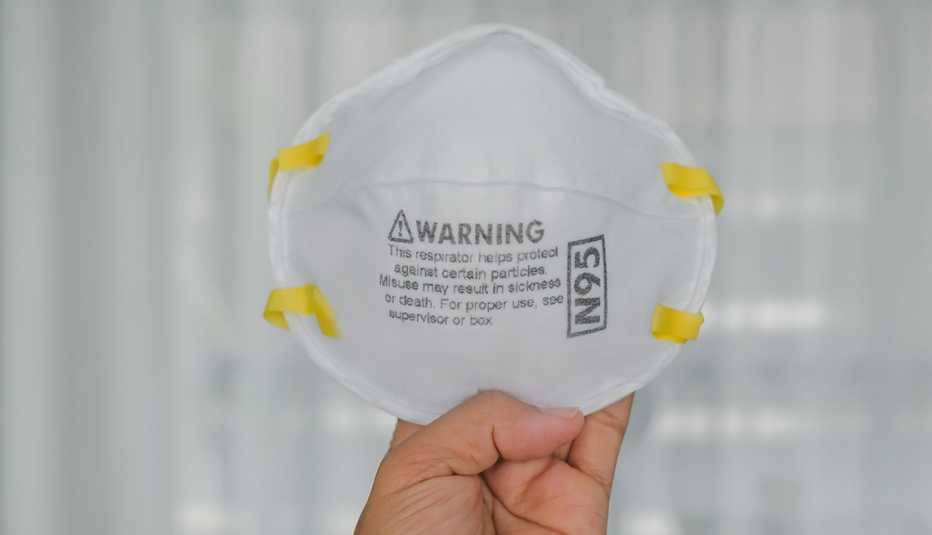Staying Fit


Older adults and people who have medical conditions that put them at higher risk for severe illness from COVID-19 may want to consider swapping out their cloth mask for an N95 mask, also known as a respirator. The same goes for people who are taking care of someone who is sick with COVID-19 and for grocery store workers, bus drivers and other individuals whose jobs require them to interact with the public. A long plane or train ride may also warrant a switch.


AARP Membership— $12 for your first year when you sign up for Automatic Renewal
Get instant access to members-only products and hundreds of discounts, a free second membership, and a subscription to AARP the Magazine.
When well-fitted and worn properly, respirator masks are better at filtering out virus-sized particles and can provide a higher level of protection against COVID-19 than other types of face masks, the Centers for Disease Control and Prevention (CDC) says in its newly revised mask guidance. But the agency stops short of recommending one mask over another, instead emphasizing that any mask is better than no mask, especially with the highly contagious omicron variant circulating.
“We want to provide Americans the best and most updated information to choose what mask is going to be right for them,” CDC Director Rochelle Walensky, M.D., said about the new guidance ahead of its release.
Loosely woven cloth masks provide the least protection, the CDC’s Jan. 14 update says, while layered finely woven products offer more. Well-fitting surgical masks and KN95s (respirators that meets an international standard) are better barriers than cloth masks. For the greatest protection, look for respirators approved by the National Institute for Occupational Safety and Health (NIOSH). They can filter at least 95 percent of particles in the air, as the name, N95, suggests.
Throughout most of the pandemic, however, Americans have been told to reserve N95s and other medical-grade masks for health care workers due to supply shortages. But health officials say these masks are now “widely available," and in the wake of omicron, which is causing a record-breaking surge in COVID-19 cases and hospitalizations, health experts have been encouraging Americans to make the switch. (Specially labeled “surgical” N95 respirators should still be reserved for health care workers.)
More than 1 million new cases of COVID-19 were recorded on Jan. 10. The previous record, in January 2021, clocked in under 300,000.
Finding a good fit is key
The key to enhanced protection for any mask, including respirators, is a proper fit, experts say. What you don’t want are gaps along the edges or around the nose that can let air in and out. (The virus that causes COVID-19 travels in small respiratory droplets in the air.)
“If the mask has a good fit, you will feel warm air come through the front of the mask and may be able to see the mask material move in and out with each breath,” the CDC says.
Respirators should form a seal to the face to work properly, the CDC says. Another factor to consider when choosing a respirator: Look for markings printed on the product to verify its authenticity. The CDC has information on what to look for when purchasing an N95 or KN95 mask.
If you don’t have access to a respirator mask, which can cost upwards of $20 for one or a box of multiple, or choose not to wear one, doubling up — wearing a cloth mask over a surgical one — can improve the fit of your mask. Opting for a mask that attaches behind the neck and head with either elastic bands or ties (instead of ear loops) is another option, the CDC says.
Even with the new guidance, Walensky maintains that the best mask “is the one that you will wear and the one you can keep on all day long — that you can tolerate in public, indoor settings and tolerate where you need to wear it.”
President Joe Biden on Jan. 13 said that the government is working to distribute “high-quality masks” to all Americans for free. These N95 masks will be available at pharmacies and community health centers throughout the country beginning late January; administration officials have said the program will be fully up and running by early February.
Rachel Nania writes about health care and health policy for AARP. Previously she was a reporter and editor for WTOP Radio in Washington, D.C. A recipient of a Gracie Award and a regional Edward R. Murrow Award, she also participated in a dementia fellowship with the National Press Foundation.
Ranking Masks' Effectiveness
Some masks are better than others when it comes to the percentage of coronavirus-sized airborne particles they’re able to filter out, research published in 2021 by the Environmental Protection Agency and others show. Here’s what their studies have found.

































































More on health
How Can I Get a Free COVID-19 at Home Test?
Private insurers must pay, but most Medicare enrollees will have to use federal websiteHow the Pandemic Will Be Different in 2022
Expect new treatments, more testing and additional variantsCOVID After Vaccination? Here's What to Do
Once-rare breakthrough infections are more common in the omicron era